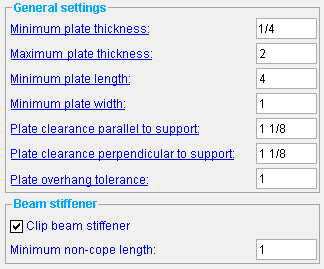Extended Flange Plate Settings ( Fabricator Settings ) (read-only)
Extended flange plates with tapered stiffeners can be designed (for erection purposes) when a column with a base/cap plate frames to a beam's flange and the column plate is wider than the beam's flange. The column " Input connection type " can be ' Auto base/cap ' or ' User base/cap ' or ' Auto standard '. The user must select ' Yes ' or ' Automatic ' for " Use extended stiffeners " (user base/cap plate) or " Use extended stiffeners " (auto base/cap plate).
Also see :
- " Use extended stiffeners " (user base/cap plate)
- " Use extended stiffeners " (auto base/cap plate)
home > project settings > fabricator > standard fabricator connections > | classic | top
To open the Extended Flange Plate Settings window :
Method 1 : Home > Project Settings > Fabricator > Standard Fabricator Connections > Extended Flange Plate Settings .
home > project settings > fabricator > standard fabricator connections > | classic | top
------ General settings ------
Minimum plate thickness: The minimum thickness (in the primary dimension " Units " or other units ) of the extended flange plate.
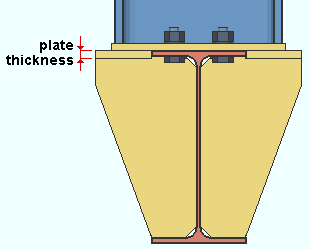
|
This and the other examples on this page show column base plates. Be aware that extended flange plates and stiffeners can also be designed for a column cap plate to a beam flange. |
Maximum plate thickness: The maximum thickness (in the primary dimension " Units " or other units ) of the extended flange plate.

|
The top surfaces of extended flange plates for beams framed to by columns with base plates are in the same plane of the top flange of the beam. |
Minimum plate length: The minimum length (in the primary dimension " Units " or other units ) of either of the extended flange plate's edges that are parallel with the beam's flange. This width applies to both the NS and FS extended flange plates.
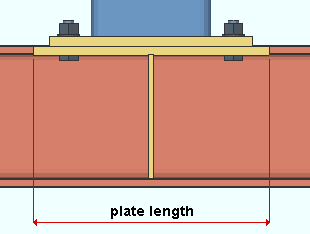
|
The designed flange plate's length is approximately equal to the length of the column plate plus two times the " Plate clearance parallel to support ." |
Minimum plate width: The minimum width (in the primary dimension " Units " or other units ) of either of the extended flange plate's edges that are perpendicular to the beam's work line . This length applies to both extended flange plates.
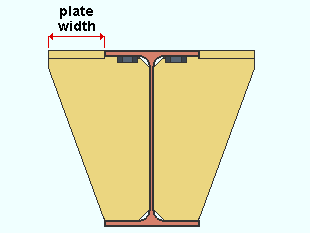
|
The designed flange plate's width is approximately equal to half the length of the column plate minus half of the beam's flange width plus the " Plate clearance perpendicular to the support ." |
Plate clearance parallel to support: The distance (in the primary dimension " Units " or other units ) from either edge of the column base/cap plate that is perpendicular to the beam's work line to the outside edge of the extended flange plate (which extends the beam's flange width). The distance is measured parallel with the work line of the beam, in the plane of the beam's flange whose flange width is being extended.
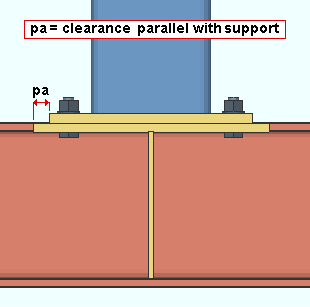
|
The " Plate clearance parallel to support " is the distance that the extended flange plate extends beyond the column plate. |
Plate clearance perpendicular to support: The horizontal distance (in the primary dimension " Units " or other units ) from either edge of the column base/cap plate that is parallel to the beam's flange to the outside edge of the extended flange plate (which extends the beam's flange width). The distance is measured in the plane of the extended flange. It is a true horizontal distance only if the column is perfectly vertical and the beam's web is vertical.
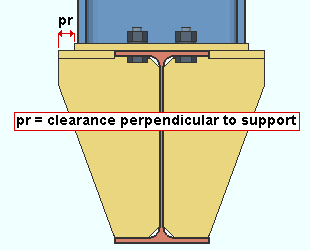
|
The " Plate clearance perpendicular to support " is the distance that the extended flange plate extends beyond the column plate. The distance is measured perpendicular to the work line of the supporting beam. |
Plate overhang tolerance: The horizontal distance (in the primary dimension " Units " or other units ) from either edge of the column base/cap plate that is parallel to the beam's flange to the beam's flange. The distance is measured in the plane of the beam's flange. It is a true horizontal distance only if the column is perfectly vertical and the beam's web is vertical.
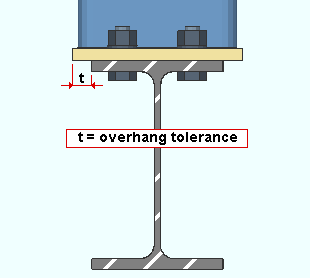
|
The " Plate overhang tolerance " is used by connection design when ' Automatic ' is selected for " Use extended stiffeners " (user base/cap plate) or " Use extended stiffeners " (auto base/cap plate). If the overhang in the model is larger than the overhang entered here, the program will attempt to design extended flange plates and stiffeners. |
------ Beam stiffener ------
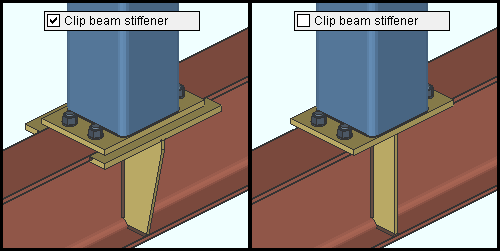
If this box is checked (
), connection design is permitted to create beam stiffener plates that taper to fit to the extended flange plates. These flange plates extend the effective flange width of the beam.
If the box is not checked (
), rectangular, non-tapered beam stiffeners will be designed.
Minimum non-cope length: The minimum distance (in the primary dimension " Units " or other units ) from the outside corner of the stiffener plate that is nearest to the extended flange plate to the corner where the stiffener plate begins to taper.
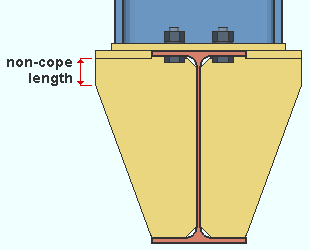
|
Assuming that the column is vertical and the beam is web vertical and not sloping, the non-cope length is a vertical distance. |
home > project settings > fabricator > standard fabricator connections > | classic | top
